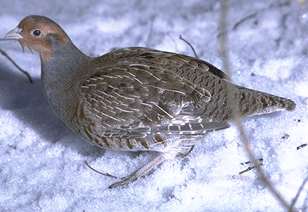


|

|
| Ringneck pheasants bring to mind the hearty cackle of a flushed rooster in the fall, but pheasants may
also be raised in a domestic environment. In fact, because the pheasant spends the greater part of its life
on the ground, it readily adapts to life in confinement. The ringneck pheasant is not native to this continent.
It was first introduced from China to the Willamette Valley of Oregon in 1881. Since that time nearly all
states have attempted to establish ringnecks. With over 20 subspecies, this species covers the most diverse
habitat of all pheasant species. In North America, pheasants are found in over 30 of the lower 48 states,
central Canada and are stocked in many more areas for hunting. The native lands of the species are divided
by the subspecies groups, ranging from Europe and east to China. Ringneck Pheasants have also been introduced
into Australia, New Zealand, Japan, Western Europe and Hawaii.
Known for their elusive tactics, ringnecks escape hunters by holding tight, flushing far out of gun range, or running. This explains why most accomplished pheasant hunters wouldn’t think of going afield without a good bird dog. Not only will a dog point or flush the birds, it will boost your odds of retrieving downed birds in the heavy cover where pheasants are typically found. The ringneck’s diet consists mostly of small grains, supplemented by weed seeds and insects. The birds prefer corn, where it is available, but will also eat wheat, oats, soybeans, sorghum and milo. Insects, particularly grasshoppers, are commonly eaten by adults and chicks; the high protein content is needed for rapid growth. Like most upland game birds, ringnecks are short lived. On the average, 80 percent of the birds taken by hunters were hatched the previous spring. Rarely does a pheasant live more than 2 years. |
| Gray Partridge is a small bird, only 30 cm (12 in.) long. Both sexes are nearly identical, but the adult male has a distinct, horseshoe-shaped, chestnut patch on its breast. Breast patches of females and immatures are broken and less distinct. In flight, chestnut tail feathers can be seen clearly. A native of the bush plains of Europe and western Asia, the species was introduced to central and southern Alberta in 1908. It is now well-established in the prairies and parklands of Alberta. In spring, the cock attracts a mate with a call that sounds like the creaking of a rusty gate. The hen builds a nest in grass or low bushes. Ten to 20 olive-colored eggs hatch in about 25 days. The hen and her chicks remain together throughout the summer, feeding on grain, seeds, leaves and berries. Mortality is high, and only about eight chicks will survive to the fall. At this time coveys of 10 to 20 birds are formed. The coveys remain together all winter, dispersing in spring as the birds pair off and mate. The gray partridge seems well-suited to Alberta's winters, using windbreaks and straw piles for shelter, and grains and other seeds for food. |
| Cabelas | Herters | Pheasants Forever | Ducks Unlimited | National Wild Turkey Federation | Minnesota Deer Hunters Association |